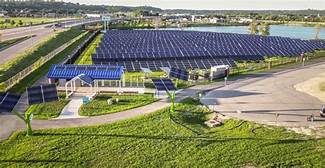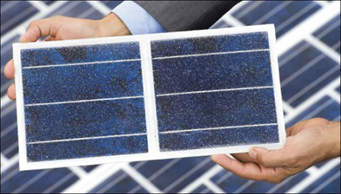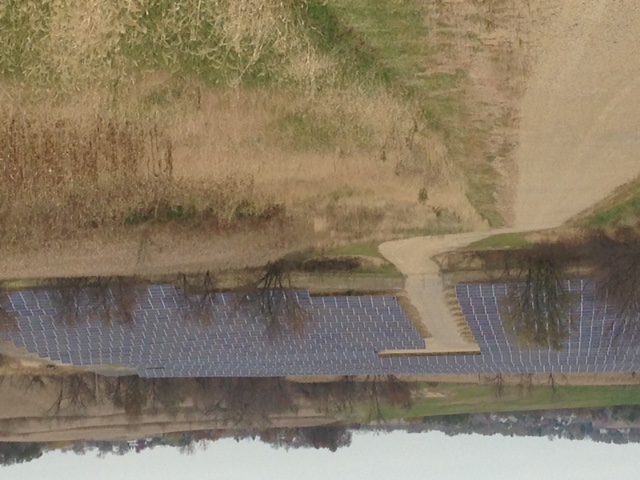Encyclopedia Dubuque
"Encyclopedia Dubuque is the online authority for all things Dubuque, written by the people who know the city best.”
Marshall Cohen—researcher and producer, CNN
Affiliated with the Local History Network of the State Historical Society of Iowa, and the Iowa Museum Association.
SOLAR ENERGY
SOLAR ENERGY. In 2011 Dubuque added a soar array to the top of its public works building. (1) Dubuque was chosen in 2014 as a pilot community for solar-readiness program funded by the Iowa Economic Development Authority. The $20,000 grant was used to examine city policies and ordinances to find easier ways of installing solar energy. (2) In 2017 based on the success of its 2011 program, the city added arrays to all the fire stations. Staffed and used around the clock, it was estimated that the enhanced use of solar would result in the reduction of 3,740 tons of carbon dioxide over the life of the panels while providig the equivalent annual electric use of 425 homes. (3)
Solar energy is one of the sources of energy termed "renewable" that began slowly gaining popularity in the 1970s. It's position relative to coal and natural gas has steadily risen. By 2009 burning coal was responsible for 44% of the energy produced in the United States while natural gas produced 23%. By 2018 coal's percentage had dropped to 27% with anticipated further decrease to 17% by 2050. Renewable energy, principally HYDROELECTRICITY in 1951 produced an estimated 5% of the nation's electricity. Renewable sources including solar panels, biofuels, and hydroelectricity produced 18% in 2018 with anticipation that it would reach 31% by 2050. (4)
Based on the examination of policies and ordinances, in addition to using rooftop solar arrays, two recommendations were made. One was the creation of a new solar permit that would simplify the application process and track solar array installation. This would also include solar installer certification classes with the GREATER DUBUQUE DEVELOPMENT CORPORATION and providing public education about incentives available or solar projects. The second recommendation was reviewing height and setback requirements for ground-mounted arrays. (5)
Due to a drop in the cost of solar energy, a proposed solar array of two sites constructed in Dubuque beginning in 2016 became the largest single site in the state of Iowa, according to officials with ALLIANT ENERGY CORPORATION. The two sites, which would span 32 acres at two spots in Dubuque, were operational by the end of 2017. One of the sites was located on 26 acres just west of Dubuque's industrial parks, and the other closer to downtown, on the site of the old A.Y. McDonald foundry. (6)
The project in Dubuque was planned to provide a blueprint for how solar energy could best be used across the state of Iowa. Both of the sites, a growing industrial site and a vacant former industrial site, were very common in Iowa. By utilizing these two sites, the company hoped to learn how to develop similar sites across the state. (7)
The site located closer to downtown was also to provide a more strategic outcome for both Alliant and the city. When completed, the entire system, operating in ideal conditions, could generate four megawatts of energy, or more practically, power more than 500 homes each year. The cost of the project would be Alliant's; it would not cost the city any out of pocket expenses. (8) By 2019 it was reported that the $10 million West Dubuque Solar Garden with more than 15000 solar panels on 21-acres was producing 5 megawatts of energy--enough to power 727 homes annually. The downtown site produced 1,2 megawatts. (9)
Between 2014 and September 1, 2016 businesses in Dubuque reduced their energy usage by 10 million kilowatt hours according to Alliant. That was equal to removing 7,392 metric tons of carbon dioxide equivalent from the air and not sending $1 million out of the community annually. MERCY MEDICAL CENTER spent $100,000 to "retro-commission" its hospital resulting in $72,000 in annual energy savings.
On October 18, 2017 officials with Alliant energy flipped a symbolic switch setting into operation the largest solar operation in the state of Iowa. The two solar gardens, based in the west part of Dubuque and the Port of Dubuque, generate a combined 6.2 megawatts a year--enough energy to power 850 homes annually.
Consumers could not immediately expect to see a lowering of their energy costs. This would occur in the future when more and larger solar facilities were installed. These solar gardens were a research project for the company. Alliant officials explained this was part of an effort to reduce carbon dioxide emissions by 40 percent by 2030. (10)
Reducing Dubuque's greenhouse gas emissions by 50% by 2030 led to the installation of solar panels on the city's seven fire stations, Jule Building, and the Historic Federal Building. In 2019 the city council approved hiring a consultant to assist in updating the city's Climate Action Plan. (11)
The growth of the solar industry led to a near doubling of the workforce from 120,000 to 242,000 nationwide from 2012 to 2018 according to the Solar Energy Industries Association. In Dubuque, officials at Eagle Point Solar cited its steady growth to the increasing "economic viability of solar" leading to increased residential installation. In 2010, the year the company opened, the installation cost $7 per kilowatt. In 2019 that cost had decreased to $2.70 per kilowatt for residential and $1.83 for commercial systems according to the National Renewable Energy Laboratory. The development of batteries that could store solar energy also made the decision to switch to it more likely. (12)
In June, 2022 a program to install solar panels on the homes of low-to moderate-income Dubuque residents began with plans to add more the following year. As part of the Renew DBQ pilot program, solar panels would be installed on ten homes to reduce energy costs while lowering the city's greenhouse gas emissions. In 2021 city council members voted to contribute $41,000 to the pilot program which would use grant funds and federal solar energy tax credits to reduce the installation costs. When the State of Iowa chose not to extend its solar energy tax credit, the city was able to use a $25,000 grant obtained by the Dubuque County Energy District to offset installation costs. City officials estimated that each solar installation would save residents an estimated $30,000 in energy costs over the 25-year lifespan of the panels. (13)
In the spring of 2024 capital improvements programs at the AIRPORT began. EAGLE POINT SOLAR began to install a solar array the first week of April. Electricity produced would power the terminal building and apron lighting. Batteries would be installed to store electricity to meet the needs at night. The project was expected to offset between $80,000 to $10,000 of the airport's annual electric costs. (14)
The DUBUQUE COMMUNITY SCHOOL DISTRICT began its involvement in solar power with a small panel on a maintenance building. Most of the energy used in the building was generated by the panel which reduced the monthly cost from $1,000i a month to approximately fifteen dollars. In 2023 the board of education voted to spend $325,140 on adding solar panels to SAGEVILLE ELEMENTARY SCHOOL. In 2024 the results of this project were as yet not known.
Alliant Energy in 2024 also had "solar gardens" around the city. One site of more than 15,000 arrays could supply enough power for 725 homes. A second site near the 16th Street detention basin of 3,500 arrays could serve 100 homes. (15)
---
Source:
1. Topping, Megan, "A Bright Future," Green Horizons, (supplement to the Telegraph Herald) June 6, 2024, p. 16
2. Barton, Thomas J. "Energy Rising for Solar Projects in Dubuque," Telegraph Herald, September 1, 2016, p. 3A
3. Topping, Megan, "A Bright Future," ...
4. Kruse, John, "Here Comes the Sun," Telegraph Herald, June 9, 2019, p. 1
5. Barton
6. Hanson, Brad. "Proposed Dubuque Solar Array Would be the Largest in the State," KWWL.com, June 23, 2016. Online: http://www.kwwl.com/story/32296895/2016/06/23/proposed-dubuque-solar-array-would-be-largest-in-state
7. Ibid.
8. Ibid.
9. Kruse, p. 6A
10. Hanson, Brad. "Largest Solar Operation in Iowa Now Generating Energy In Dubuque," KWWL.com. October 19, 2017, Online: http://www.kwwl.com/story/36632788/2017/10/19/largest-solar-operation-in-iowa-now-generating-energy-in-dubuque
11. Kruse, p.6A
12. Ibid.
13. Kruse, John, "Dubuque Progressing on Mid-Low-income Solar Program, Plans to Expand," Telegraph Herald, May 15, 2022, p. 4A
14. Piper, Andy, "Solar Array to Power Dubuque Airport Terminal," Telegraph Herald, April 3, 2024, p. 1A
15. Topping, Megan, "A Bright Future," Green Horizons, (supplement to the Telegraph Herald) June 6, 2024, p. 17




